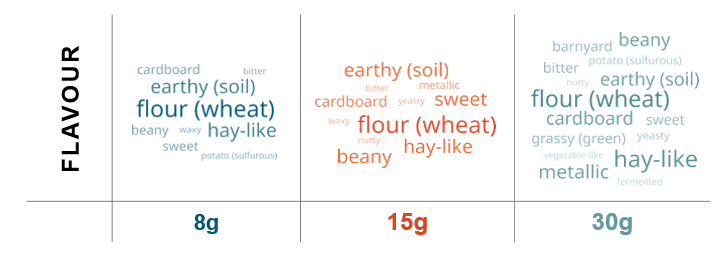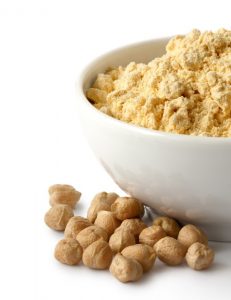The use of plant-based proteins has been growing around the world in the food and beverage market in recent years, especially for use in meat analogues. However, the protein sources used in these foods can bring unpleasant tastes such as bitter, earthy, beany, astringent, and green which have become major obstacles for consumers as well as for food manufacturers. Reducing the off-taste of different plant-based proteins is more complicated than it seems, but understanding how to do so is a key to helping plant-based foods thrive in mainstream markets.

The growth of plant-based meat alternatives can be linked to health. Over the years, meat consumption’s repeated link to disease like cancer in studies and media headlines has caused many people to eat less meat.
Pea protein continues to be a popular choice of plant protein in meat alternatives. The main reason for this is their high protein content, as well as the low saturated fat and high fiber content. As the plant protein trend continues, both consumers and manufacturers look towards new and innovative sources for their food and beverage products. Among the plant-based proteins, lentil, chickpea, rice, fava, hemp and potato are rapidly growing in interest.
What affects the off-tastes of a plant protein?
-
- Amount of protein in the product
- Type of protein used
- Extraction process: pH, temperature, processing time
- Precipitation process: centrifugation conditions, fermentation microorganisms used, etc.
- Drying temperature
- Consumer storage and preparation conditions
Understanding the source of off-tastes is the first step in properly masking them. Typical plant-based protein off-tastes include: beany, bitter, cardboardy and chalky. There might also be unpleasant perceptions around aroma, mouthfeel, and astringency.
The off-tastes can be associated with varying amino acid profiles which are derived from plant-based proteins. They all have unique, inherent off-tastes along with green aftertaste depending on the plant source.
The amount of plant-based proteins used, the types of protein used, and the protein extraction/processing/drying methods all play critical roles in generating the types of off-tastes perceived in the finished application.

Off-tastes in plant proteins differ depending on how much of the protein is in a serving of food or beverage.
Starting at the raw material, the type of protein and its serving size both dramatically contribute to off-tastes. It’s then important to take into account how the plant protein has been extracted, precipitated, and dried from the manufacturer. During extraction, the pH, temperature, processing time, and the types of treatment chemicals used can all contribute to off-notes. During precipitation, the sedimentation method, centrifuge condition (rpm, flow rate, operation time) and, if fermentation is involved, the type of microorganisms used, can all contribute to off-notes as well.

During drying, the temperature (inlet and outlet) of the spray dryer and the drying methods (freeze drying, drum drying and etc.) can contribute to off-notes.
In summary, the proprietary process that a manufacturer is using to produce the plant-based proteins will contribute its own unique off-taste. To further complicate the matter, there are a number of challenges for the developer when formulating with plant-based proteins such as different product formats, consumer’s cooking methods, storage conditions of the finished products, working with multiple suppliers with different off-note challenges, and batch to batch off-taste variation.
The principles of plant-based protein flavour masking
In order to mask multidimensional off-tastes, a multidisciplinary approach is required.
During the manufacturing process, off-flavouring molecules (e.g. specific amino acids) can be removed using physical or chemical treatments such as soaking, thermal treatment, germination, enzymatic treatment, or solvent extraction.
Another option is to mask off-taste using making agents. A major challenge is the increase in demand for natural and organic masking agents. Claims such as natural, halal, kosher, non-GMO, and organic make it difficult to use many traditional or artificial flavouring agents.
To develop clean labelled flavour masking agents, an understanding of analytical chemistry and sensory science for volatile and non-volatile compounds are required. By understanding the flavour chemistry mechanisms, one is in a better position to correlate the off-tastes to critical flavour compounds as well as to enable to the development of effective flavour masking solutions.

Off-tastes in pea protein are linked to specific chemistry. For example, in the chart above, high amounts of lipid oxidation are linked to a strong hay off-taste. Understanding what is causing off-tastes helps solve the issue at its root.
For example, prolamin coating is a known method for bitter taste masking. Prolamin is a plant storage protein which is mainly found in the seeds of cereal grains such as oat and rice and accounts for about 5-10 % of the total proteins in those plants. Manufacturers and flavour companies could produce a clean labelled flavour masking agent through extraction, separation, and purification of prolamin-rich fractionation.
Traditionally, addition of sugars, salts, and acids are used for suppressing the inherent off-taste through trial and error. However, understanding the chemistry and source of off-notes can help the masking process be more time efficient and better for health, without requiring excessive use of sugars or salts that are linked to poor health.

 Peter oversees research activities within Kerry’s Taste Innovation team. He has responsibility for developing new and novel flavour/taste molecules and flavour-related technologies specific to taste modulation to support the creation of unique taste solutions across a range of applications.
Peter oversees research activities within Kerry’s Taste Innovation team. He has responsibility for developing new and novel flavour/taste molecules and flavour-related technologies specific to taste modulation to support the creation of unique taste solutions across a range of applications. 

